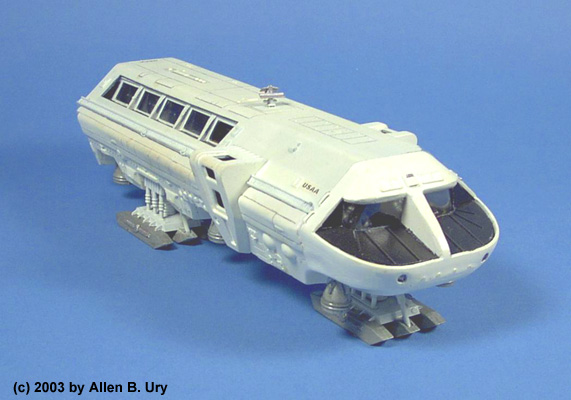
Those nerds are seven years behind schedule already.
Posted on 02/07/2006 7:53:20 AM PST by presidio9

Those nerds are seven years behind schedule already.

Naaah, only 5 years behind.
About fracking time. Our abandonment of a meaningful space program since Apollo is one of the great tragedies of the past 100 years.
No it isn't. The government-funded space program is a total waste of money.
American military dominance of earth orbit and the moon must be a high priority.
Spending taxpayer dollars to find planets billions of miles away? Questionable.
Just like the international space station and space shuttle. Let's cut doing science in favor of manned technologies that go places but don't do anything. Disgusting. The programs being cut are, to me, the most exciting ones NASA was doing - building the technology where we could see planets, and look for the chemistries of life! The discoveries of those missions would be history making! Or maybe the ID-supporting Bush doesn't beileve life may exist on other planets because it's not in the Bible so the science gets cut.
I don't want to be paying for any of this stuff. None of it makes my life better.

1. Rare minerals that are worth more than the transport costs.
2. Low gravity way-station to the planets, asteroid belt.
3. Military base.
4. Solar panels that can be transmitted as energy.
Going there just because it's there isn't good enough.
If humans are really going to expand into the solar system, there has to be a significant off-Earth infrastructure in place to support it. It's too expensive, and the timescale for return on investment is far too long, for private industry to make it happen.
From that perspective, building infrastructure on the moon makes a great deal of sense.
Heart monitors
Silicon chips
Tang
Velcro
Carbon fiber
Modern manufacturing methods
GPS
Telecommunications
Etc.
I'm sorry Dave . . .you can't post that !!
(evil grin)
"I don't want to be paying for any of this stuff. None of it makes my life better."
Yes it does. Without the Apollo program, there would be no ICBM's (at least in the U.S.) That would have made MAD a tougher sell to the Soviets. There also would be half as many scientists in America, many of whom are motivated to go into their profession by the manned space program. There have been dozens of experiments performed in space by men and women which are priceless in medical and material science. But if you don't want to know about it, then it's an easy self-delusion.
You mean rare minerals like Helium-3 for easy and cheap fusion?
Items 2 and 3 are obvious.
As for solar panels, it's easier and cheaper to use lunar materials to build large solar arrays in high orbit, preferably geosynchronous orbit, and beam the power down via either microwaves or infrared laser. . .
If we don't then the other guys will.
Russia, China, India and EU have all announced moon plans
From Russia to the Moon ( Russia wants to mine for energy)
Newsmax ^ | January 30 2006
Monday, Jan. 30, 2006 11:45 a.m. EST Russia to Mine Moon for Energy
Russian space officials announced plans last week to build a permanent base on the moon to mine isotope helium-3, a promising fuel for nuclear energy.
With the move, Russia joined the United States in pushing for a permanent presence on the moon and in encouraging speculation on helium-3’s feasibility for energy production on earth.
"We are planning to build a permanent base on the moon by 2015,” said Nikolai Sevastyanov, head of the Energia space corporation, at an academic conference as reported by the ITAR-TASS news agency.
"By 2020,” he continued, "we can begin the industrial-scale delivery of the rare isotope helium-3.”
President Bush called for the creation of a permanent U.S. base on the moon in early 2004. Bush’s announcement also generated speculation about U.S. interest in helium-3.
Some scientists believe the isotope could be the next great source of energy for the world.
Gerald Kulcinski, a nuclear engineering professor at the University of Wisconsin – Madison, told the Milwaukee Journal-Sentinel in January 2004 that helium-3 could transform energy production without causing harm to the environment.
"If we could land a space shuttle on the moon, fill the cargo with canisters of helium-3 mined from the surface and bring the shuttle back to Earth,” Kulcinski promised, "that cargo would supply the entire electrical power needs of the United States for an entire year.”
And, he continued, helium-3 "doesn’t produce greenhouse emissions. It’s safe for the environment.”
Another scientist, John Santarius of the University of Wisconsin’s Fusion Technology Institute, told the Journal-Sentinel that helium-3 provides one million times more energy per pound than a ton of coal.
Though rare on earth, the isotope is abundant on the moon. Kulcinski’s research team has estimated that more than 1 million metric tons is trapped in the upper layers of lunar rock.
If their calculations are correct, the moon would contain enough helium-3 to power 1,000 years of electricity in the United States.
In fact, the government actually broke ground by financing private sector innovation. As an example, when Motorola first invented a process for shrinking a circuit down to a silicon wafer, they went to the government and said, "we have this, but we really don't have an application for it." There was no private sector demand yet, and it was not financially feasible to speculate on a chip-based product for public or commercial consumption. NASA put them in the chip business by committing to buy all the chips they could make to NASA specs for use in miniaturized sensing equipment for flight dynamics testing.
Disclaimer: Opinions posted on Free Republic are those of the individual posters and do not necessarily represent the opinion of Free Republic or its management. All materials posted herein are protected by copyright law and the exemption for fair use of copyrighted works.